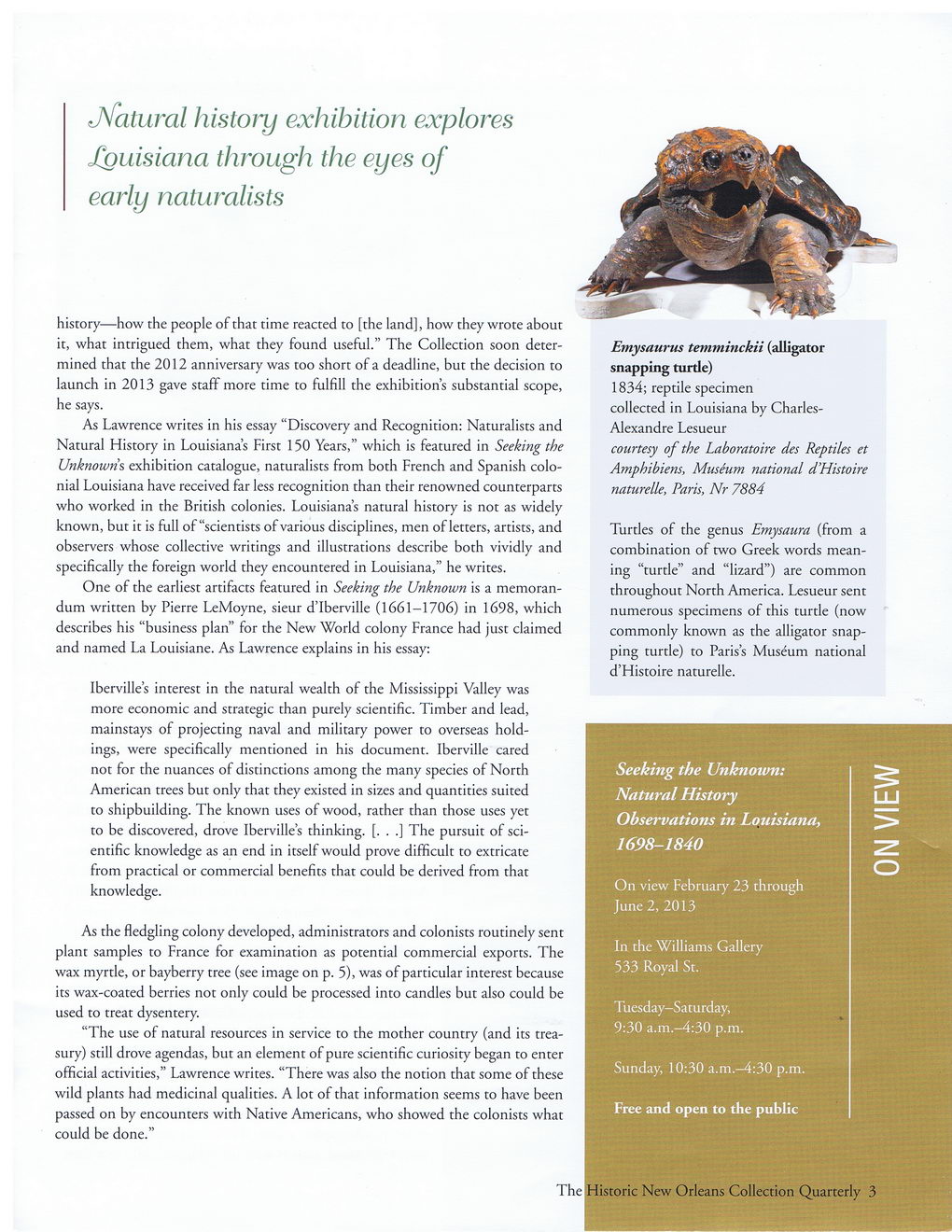This text was obtained via automated optical character recognition.
It has not been edited and may therefore contain several errors.
'Natural history exhibition explores Louisiana through the eyes of early naturalists history—how the people of that time reacted to [the land], how they wrote about it, what intrigued them, what they found useful.” The Collection soon determined that the 2012 anniversary was too short of a deadline, but the decision to launch in 2013 gave staff more time to fulfill the exhibition’s substantial scope, he says. As Lawrence writes in his essay “Discovery and Recognition: Naturalists and Natural History in Louisiana’s First 150 Years,” which is featured in Seeking the Unknowns exhibition catalogue, naturalists from both French and Spanish colonial Louisiana have received far less recognition than their renowned counterparts who worked in the British colonies. Louisiana’s natural history is not as widely known, but it is full of “scientists of various disciplines, men of letters, artists, and observers whose collective writings and illustrations describe both vividly and specifically the foreign world they encountered in Louisiana,” he writes. One of the earliest artifacts featured in Seeking the Unknown is a memorandum written by Pierre LeMoyne, sieur d’Iberville (1661-1706) in 1698, which describes his “business plan” for the New World colony France had just claimed and named La Louisiane. As Lawrence explains in his essay: Iberville’s interest in the natural wealth of the Mississippi Valley was more economic and strategic than purely scientific. Timber and lead, mainstays of projecting naval and military power to overseas holdings, were specifically mentioned in his document. Iberville cared not for the nuances of distinctions among the many species of North American trees but only that they existed in sizes and quantities suited to shipbuilding. The known uses of wood, rather than those uses yet to be discovered, drove Iberville’s thinking. [. . .] The pursuit of scientific knowledge as an end in itself would prove difficult to extricate from practical or commercial benefits that could be derived from that knowledge. As the fledgling colony developed, administrators and colonists routinely sent plant samples to France for examination as potential commercial exports. The wax myrtle, or bayberry tree (see image on p. 5), was of particular interest because its wax-coated berries not only could be processed into candles but also could be used to treat dysentery. “The use of natural resources in service to the mother country (and its treasury) still drove agendas, but an element of pure scientific curiosity began to enter official activities,” Lawrence writes. “There was also the notion that some of these wild plants had medicinal qualities. A lot of that information seems to have been passed on by encounters with Native Americans, who showed the colonists what could be done.” Emysaurus temminckii (alligator snapping turtle) 1834; reptile specimen collected in Louisiana by Charles-Alexandre Lesueur courtesy of the Labomtoire des Reptiles et Amphibiens, Museum national d’Histoire naturelle, Paris, Nr 7884 Turtles of the genus Emysaura (from a combination of two Greek words meaning “turtle” and “lizard”) are common throughout North America. Lesueur sent numerous specimens of this turtle (now commonly known as the alligator snapping turtle) to Paris’s Museum national d’Histoire naturelle. The Seeking the Unknown: Natural History Observations in Louisiana, 1698-1840 On view February 23 through June 2,2013 In the Williams Gallery 533 Royal St. Tuesday-Saturday, 9:30 a.m.—4:30 p.m. Sunday, 10:30 a.m.-4:30 p.m. Free and open to the public Historic New Orleans Collection Quarterly 3

New Orleans Quarterly 2013 Winter (03)